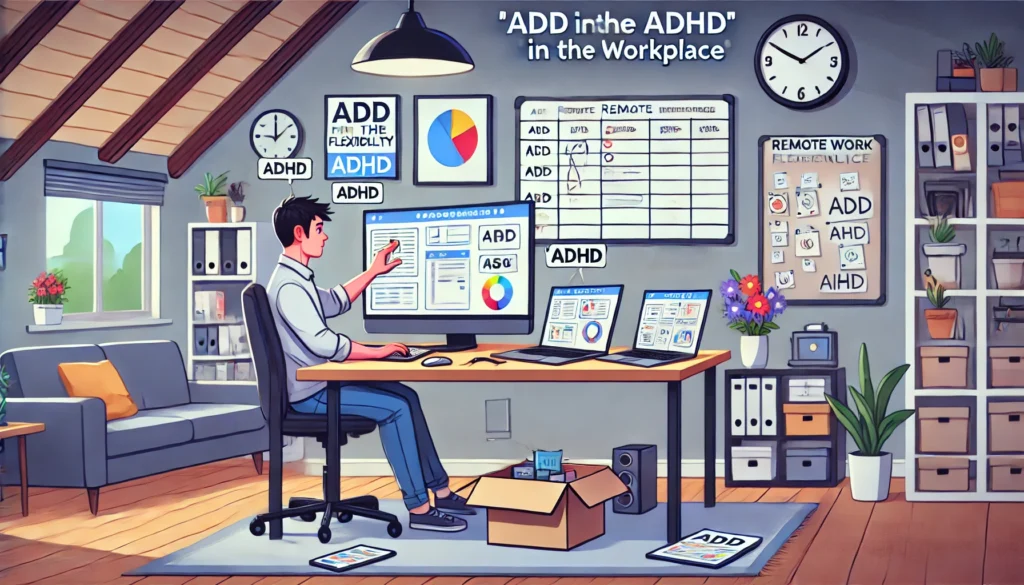ADHD is a neurodevelopmental disorder characterized by symptoms such as inattention, hyperactivity, and impulsivity. These symptoms can present unique challenges in a work environment, where sustained focus, organization, and time management are often crucial for success. However, it’s important to recognize that ADHD is not merely a hindrance; individuals with ADHD often possess unique strengths such as creativity, problem-solving skills, and the ability to hyper-focus on tasks of interest.
You may also like: Enhancing Concentration: Strategies for ADHD
The Impact of ADHD on Employment
The workplace can be a daunting arena for individuals with ADHD. Many face difficulties in securing and maintaining employment, not due to a lack of capability, but because traditional work environments may not cater to their unique needs. Understanding these challenges is the first step toward creating a supportive work environment for individuals with ADHD.
Time Management Challenges
Time management can be a significant hurdle. Individuals with ADHD often struggle to meet deadlines and juggle multiple tasks. This is not due to a lack of desire or effort, but because their brains process time differently. Strategies to combat this include breaking tasks into smaller chunks and using visual timers to track progress.
Organizational Obstacles
Keeping track of details and maintaining an organized workspace can be tough. Disorganization can lead to missed deadlines and forgotten tasks, further increasing stress levels. Implementing organizational systems like color-coding and filing can help mitigate these issues.
Focus and Distractibility
Workplace distractions can severely impact concentration. Open office layouts, frequent interruptions, and digital notifications can derail focus. Identifying personal triggers and creating a customized distraction management plan can significantly improve concentration.
Harnessing Unique Strengths
While ADHD presents challenges, it also brings unique strengths to the workplace.
Creativity and Innovation
Many individuals with ADHD have a natural propensity for creativity and out-of-the-box thinking. This can be a tremendous asset in roles that require innovation and problem-solving.
Hyper-Focus Abilities
When engaged in tasks they find interesting, individuals with ADHD can often enter a state of hyper-focus. This intense concentration can lead to exceptional productivity and quality work.
Resilience and Adaptability
Living with ADHD requires adaptability and resilience. These individuals often develop a unique ability to navigate challenges and can be incredibly resourceful in dynamic work environments.

Strategies for Managing ADHD at Work
Implementing effective strategies can transform potential obstacles into opportunities for success. Here are some practical approaches:
Structured Routines and Schedules
Developing a consistent daily routine can help individuals with ADHD manage their time more effectively. Utilizing planners or digital calendars to schedule tasks and set reminders can keep individuals on track and reduce the likelihood of missed deadlines.
Utilizing Time Blocks
Time blocking involves dedicating specific chunks of time to particular tasks. This method helps in maintaining focus and ensuring that all necessary tasks receive appropriate attention.
Setting Clear Priorities
Determining the most important tasks at the start of each day can help in navigating through responsibilities without feeling overwhelmed. Ranking tasks by urgency and impact is an effective prioritization strategy.
Regular Review and Adjustment
Regularly reviewing schedules and routines can identify what is working and what needs adjustment. Flexibility is key to finding the most effective structure.
Creating a Distraction-Free Workspace
Designing an environment that minimizes distractions is crucial. This might involve using noise-cancelling headphones, organizing the workspace to reduce clutter, or even negotiating a quieter workspace with employers.
Personalizing Your Space
A personalized workspace can increase comfort and productivity. Adding personal touches that promote calmness and focus can be beneficial.
Managing Digital Distractions
Digital devices are a major source of distraction. Utilizing apps that block distracting websites and turning off unnecessary notifications can help maintain focus.
Negotiating Environmental Changes
When possible, negotiating environmental changes with employers, such as moving to a quieter area or having access to private spaces, can be invaluable for maintaining concentration.
Task Prioritization and Breaks
Breaking down larger tasks into smaller, manageable segments can prevent overwhelm and increase productivity. Incorporating regular breaks can also refresh focus and improve concentration.
The Power of Micro-Tasks
Breaking tasks into micro-tasks makes them less daunting and easier to tackle. Completing these smaller tasks provides a sense of accomplishment and motivation.
Incorporating Regular Breaks
Scheduled breaks can prevent burnout and sustain energy levels. Techniques like the Pomodoro Technique encourage taking short, regular breaks to boost efficiency.
Managing Energy Levels
Understanding personal energy patterns can help in scheduling demanding tasks during peak concentration times and lighter tasks during low-energy periods.
Tools and Resources to Aid Success
Technology can be a valuable ally for individuals with ADHD in the workplace. Here are some tools that can enhance productivity:
Digital Task Managers
Applications like Trello, Asana, or Todoist allow for the organization of tasks, setting deadlines, and tracking progress. These tools can help individuals prioritize tasks and manage their workload effectively.
Customizing Task Boards
Customizing task boards to fit personal workflow preferences can enhance usability. Color-coding and categorizing tasks by project or priority are effective strategies.
Integrating with Calendars
Many task managers can integrate with digital calendars, providing a comprehensive view of tasks and deadlines in one place.
Collaborative Features
For team-based projects, these tools offer collaborative features that enable sharing of task lists and progress updates, enhancing team communication and coordination.
Time Management Apps
Using apps like Pomodoro Timer or Focus@Will can encourage time management skills and help maintain focus. These tools provide structured intervals of work and rest, promoting sustained productivity.
Exploring Different Techniques
Different time management techniques work for different people. Exploring various methods, such as timeboxing or the Eisenhower Matrix, can help find the most effective approach.
Setting Realistic Goals
Setting achievable goals within time management apps can prevent feelings of failure and boost motivation. Gradually increasing complexity and duration of tasks can enhance endurance.
Monitoring Progress
Regularly monitoring progress within these apps can provide insights into productivity patterns and areas for improvement.
Note-Taking and Organization Apps
Evernote and OneNote are excellent tools for capturing ideas, organizing notes, and managing information. They allow users to create a structured system for tracking important details and ideas.
Creating Consistent Systems
Developing a consistent system for note organization can prevent information overload. Using tags, folders, and searchable keywords can streamline retrieval.
Visual Note-Taking
For visual learners, incorporating images, diagrams, and mind maps into notes can enhance understanding and retention.
Syncing Across Devices
The ability to sync notes across multiple devices ensures access to important information whenever needed, promoting flexibility and convenience.

Working with Someone with ADHD
For colleagues and managers, understanding how to support individuals with ADHD can foster a more inclusive and productive work environment.
Open Communication
Encouraging open dialogue about work preferences and challenges can lead to tailored support and accommodations that benefit both the individual and the team.
Regular Check-Ins
Scheduling regular check-ins can provide opportunities for discussing progress, addressing challenges, and making necessary adjustments to support strategies.
Creating a Safe Space
Fostering an environment where individuals feel safe to express their needs and concerns without judgment is crucial for effective communication.
Encouraging Feedback
Encouraging feedback from employees with ADHD can offer valuable insights into how workplace practices can be improved to support diverse needs.
Flexible Work Arrangements
Offering flexible work hours or remote work options can help individuals with ADHD manage their workload in a way that suits their strengths.
Understanding Individual Preferences
Recognizing that each individual has unique preferences and needs can guide the development of personalized work arrangements that enhance productivity.
Promoting Remote Work Options
Remote work can minimize distractions and allow individuals to create their ideal work environment, boosting focus and efficiency.
Evaluating Work Outcomes
Evaluating work outcomes rather than processes can provide flexibility and empower employees to work in ways that maximize their strengths.
Fostering a Positive Work Environment
Creating an atmosphere that values diversity and promotes understanding can empower individuals with ADHD to contribute their unique perspectives and talents.
Celebrating Diverse Strengths
Recognizing and celebrating the diverse strengths that individuals with ADHD bring to the workplace can enhance morale and inclusivity.
Providing Training and Resources
Offering training sessions and resources on ADHD and neurodiversity can promote understanding and empathy among team members.
Building Support Networks
Encouraging the formation of support networks and employee resource groups can provide a sense of community and shared experiences.

Historical Context and Future Implications
The understanding of ADHD has evolved over time, with historical perceptions often stigmatizing the disorder. Today, there is a growing recognition of the diverse capabilities and potential of individuals with ADHD. As we move forward, the integration of inclusive practices and supportive tools in the workplace will continue to be pivotal in harnessing the strengths of individuals with ADHD.
Evolution of ADHD Perception
Historically, ADHD was misunderstood and stigmatized. Increased awareness and research have shifted perceptions, recognizing the disorder as a spectrum with diverse manifestations and strengths.
Early Misconceptions
In the past, ADHD was often dismissed as poor behavior or lack of discipline. This misconception led to stigmatization and inadequate support for individuals.
Advances in Research
Ongoing research has uncovered the neurological basis of ADHD, enhancing understanding and leading to more effective treatments and strategies.
Changing Attitudes
Societal attitudes towards ADHD are gradually changing, with increased advocacy for acceptance and accommodation of neurodiversity in all areas of life.
The Role of Advocacy and Education
Advocacy and education play crucial roles in shaping future workplace practices. Organizations and individuals advocating for ADHD awareness contribute to creating more inclusive environments.
Promoting Awareness Campaigns
Awareness campaigns can educate the public and employers about ADHD, reducing stigma and promoting acceptance.
Supporting Legislative Changes
Advocating for legislative changes that protect the rights of individuals with ADHD ensures equal opportunities in the workplace.
Encouraging Continued Research
Supporting research initiatives can lead to new insights and strategies for managing ADHD, benefiting individuals and workplaces alike.
Future Implications for Workplaces
As workplaces evolve, there is an opportunity to integrate inclusive practices that recognize and leverage the strengths of individuals with ADHD.
Embracing Neurodiversity
Embracing neurodiversity can lead to more innovative and dynamic workplaces. Diverse perspectives can drive creativity and problem-solving.
Developing Inclusive Policies
Creating policies that support diverse work styles and needs can lead to increased employee satisfaction and retention.
Investing in Training and Development
Investing in training programs that focus on inclusivity and understanding of ADHD can enhance workplace culture and productivity.
Conclusion
Choosing the right add-ins for success in the workplace involves a combination of structured strategies, supportive tools, and an inclusive work culture. By addressing the challenges and leveraging the strengths of individuals with ADHD, we can create environments where everyone has the opportunity to thrive.
This comprehensive approach not only enhances individual job performance but also enriches the workplace with diverse talents and perspectives. As we continue to learn and adapt, the future holds promise for greater inclusivity and success for all. By fostering understanding and implementing supportive practices, we pave the way for a more equitable and productive work environment for individuals with ADHD and beyond.
Further Reading:
Focusing on ADD in the Workplace
ADHD at Work: Time Wasters and Productivity Killers
How to Focus at Work With ADHD
Important Note: The information contained in this article is for general informational purposes only, and should not be construed as health or medical advice, nor is it intended to diagnose, prevent, treat, or cure any disease or health condition. Before embarking on any diet, fitness regimen, or program of nutritional supplementation, it is advisable to consult your healthcare professional in order to determine its safety and probable efficacy in terms of your individual state of health.
Regarding Nutritional Supplements Or Other Non-Prescription Health Products: If any nutritional supplements or other non-prescription health products are mentioned in the foregoing article, any claims or statements made about them have not been evaluated by the U.S. Food and Drug Administration, and such nutritional supplements or other health products are not intended to diagnose, treat, cure, or prevent any disease.


